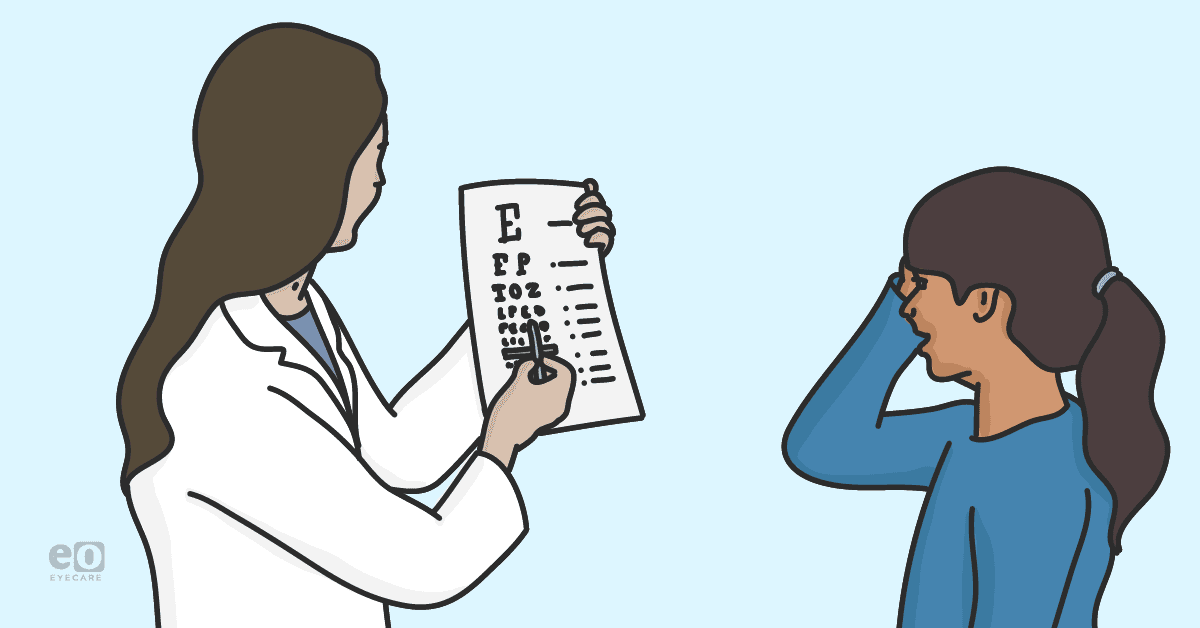Your patient complains of eye strain at night. Headaches on the computer. Blurry vision in their contacts. Poor performance in school. Refraction shows no change. 20/20.
Elicit the complaint: (10 seconds)
- Do you ever get eye strain or headaches from computer or reading, or carsick easy?
- If they respond with any kind of complaint, proceed with binocular vision testing.
Accommodation / Focus system: (1 minute) – cannot do after dilation drops.
- Binocular:
- After manifest refraction, measure how much minus they can take at near (PRA). Pre-presbyopes should be able to take at least -1.00. If it’s reduced, test with one eye covered.
- Monocular (maybe):
- If accommodation is normal in each individual eye, but reduced together, then it’s a binocular problem, and you will solve it below.
- If either or both eyes can’t accommodate alone, then it’s an accommodative paresis problem.
Vergence / Phoria / Alignment system: (2 minutes)
- Cover test at distance and near.
- Through glasses. Get good at ballpark guesstimating how much it is, so you don’t have to play with prisms for forever. To me the prism usually looks like how many degrees off they are looking (10 degrees = 10 prism). Any eso, or a large exo is a red flag.
- Vertical Phoria at near.
- Put them in the phoropter at near, and put in the prisms to give them diagonal double vision. Measure by sliding one up or down with both eyes open until it lines up. I usually repeat this from base up and base down.
- Horizontal fusion range. (Confirms cover test suspicions)
- Go back to single vision with prisms at zero, and measure their fusion range before it doubles (base-in, and base-out). A very narrow or very lop-sided range is a red flag.
Trial frame your solution. (2 minutes)
- Both eyes can’t accommodate – they need an add, even if they’re 5 years old.
- One eye can’t accommodate – usually this doesn’t bother patients. If it does, consider multifocal contact, a bifocal add in both eyes, or single vision computer glasses with a full-field add in only one eye. Trial it and see what the patient likes.
- Vertical prism – cut the prism in half for trial frame (if they measured 2, trial frame 1). Leave their specs on, and have them look at a reading target – magazine, computer, or eye chart. Drop the vertical prism in as a loose lens. If they feel like it’s “better” in any way, prescribe it.
- Horizontal prism – Compare distance and near phorias. Which one is the problem, or is it both? Start trial frame at around 1/3 to 1/2 of their phoria (ex. A 4 eso would start with 2 BO prism).
- Normal Distance, Eso Near = convergence excess – fix with patient’s choice of either an add or a prism at near only (trial frame about a third to half of their phoria). Usually they like the add better.
- Normal Distance, Large Exo Near = convergence insufficiency – fix with vision therapy or prism at near only. You can either do 2 pairs of specs, or contacts with specs over the contacts for near that just have prism.
- Large Exo Distance, Normal or Exo Near = divergence excess or exo – This usually is not strainy for the patient. If they are concerned with cosmetics of intermittent strabismus, discuss vision therapy or strab surgery.
- Eso Distance, Normal or Eso Near = divergence insufficiency or eso – base-out prism.
Want more tips on binocular vision disorders? Check out our downloadable study guide!
This is what your exam looks like:
- Question: “Do you get strainy headaches?” Yes.
- Binocular accommodation = normal (-2 to -3)
- Monocular accommodation = (skip it b/c binocular was normal)
- Cover test distance = normal (ortho/exo)
- Cover test near = normal (ortho/exo)
- Vertical phoria = 2pd BU OD, confirmed from both directions.
- Horizontal fusion range = (skip it b/c cover test was normal)
- Trial frame = 1pd BU OD over specs, on the computer. “That’s better. It’s just sharper. It looks worse when you take it away.”
- Final rx = normal spec rx, with 0.5pd BU OD, and 0.5 BD OS (split it in the specs).
Post strab surgery patients will have crazy-insane cover test results, like that each eye goes up, or one is ortho always and the other is exo always, which doesn’t make sense. Ignore most of this. Trial frame prism you think might help, and see if the patient likes anything.
Stories:
- 38-year-old with large exophoria that sometimes drifted to a strabismus, but felt great. I mentioned surgery for cosmesis. He said no one had mentioned that was even a possibility. He did the surgery and is very happy.
- I had a surgeon with convergence insufficiency. I gave him a second pair of specs with an add and base-in prism and he relies on them now.
- I had a police officer with a head tilt that ended up being a vertical phoria. She said no one had ever measured or explained anything about binocular vision to her, and now sends me many referrals.
Summary:
Cheat sheet
Check out these COVD Resources:
- Learn what COVD has to offer students and residents!
- Sign up for your FREE COVD membership here!
- Already a member of COVD? Access programs and benefits here.
- Come experience the ‘COVD Family’ in person this April–Travel Grants available!
